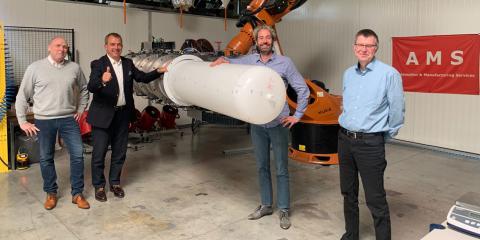Flanders Make and AMS Robotics work together on a lightweight hydrogen tank for the car of the future

Flanders Make and AMS Robotics work together on a lightweight hydrogen tank for the car of the future
Companies are always looking for ways to make their products lighter in view of reducing their impact in terms of environmental burden, energy costs, maintenance and transport. Cars, in particular, are becoming ever lighter, with the search for lighter materials being prompted mainly by environmental considerations. Conventional steel is therefore being increasingly replaced by a mix of materials. Applications range from exterior mirror housings to large body parts and even structural heat-resistant bonnet components. A group of companies, universities and research centres from various countries in the Maas-Rhine region are now pooling their knowledge and conducting research into lighter-weight materials for the automotive industry. Flanders Make and AMS Robotics, a Belgian world leader in automation and robotics, participate in the project and are working closely together to optimise a hydrogen tank that we will find in the cars of the future. In this way, we contribute to safer and lighter cars that consume less and emit less CO2.
The car of the future is powered by hydrogen
Hydrogen technology is still in its early stages, but a fuel cell car combines the advantages of electric cars with those of internal combustion engines: quiet, low in CO2 emission and a full tank in a maximum of 5 minutes. However, the technology also comes with a few challenges. One of these challenges is storage. It is not without danger because hydrogen is flammable, the more so as it is stored under extremely high pressure in order to occupy as little space as possible.
In order to guarantee lightness, the fuel tank is made of polymers and reinforced with carbon fibre. AMS Robotics from Bilzen developed for this a unique variant of the rotational moulding production process with the help of a robot. ‘Our robot set-up carries and rotates a large mould filled with plastic. Through the controlled heating and subsequent cooling of the mould, the plastic will harden against the side, giving us a hollow and seamless product', says Johan Potargent, CEO of AMS Robotics. ‘Our automated version is much faster and more cost-efficient than traditional rotary moulding, which involves sliding moulds into an oven and then allowing them to cool down. Besides, we have more control over the process parameters, which not only greatly improves dimensional stability, but also allows to produce multi-layer products with optimal properties', explains Johan.
Crossing boundaries for successful innovations
The AMS Robotics machine is able to produce hollow plastic shapes completely autonomously and the applications are endless. The company therefore does not work exclusively for the automotive industry. The huge weight reductions are a dreamed opportunity for the automotive industry to innovate and achieve efficiency gains. Moreover, robotics is already well established in this sector.
Flanders Make and AMS Robotics joined forces and knowledge in the European project "Light Vehicle 2025", in which research institutes and companies from Belgian and Dutch Limburg, as well as the Liège and Aachen region, jointly focus on the development of lightweight techniques and stronger value chains in the automotive sector. The automotive industry is well represented in this region and by connecting competences, the partners are building a virtual technology centre for the automotive technology of the future. ‘That future not only requires new and lighter materials that reduce fuel consumption or can increase the range of electric cars, but also innovative production processes', says Philip Eyckens, Flanders Make's project leader. ‘We use the knowledge and experience of companies and strengthen the cooperation between them and research institutions in the region to help shape the car of the future.'
SME within a global market
The automotive industry's supply chain is mainly made up of SMEs, which means that the knowledge and ability to further advance materials and technologies is often limited by the small scale from which they operate. The assets of the Maas-Rhine region unlock the huge opportunities of cross-border cooperation, enabling companies to respond more quickly to market demands. ‘For AMS Robotics, it is very important to create links with large companies. Thanks to the cooperation, we can demonstrate our new technology in a simple and clear way. In this way, these big players can see with their own eyes the possibilities of a further optimisation of their production process', says Johan from AMS Robotics.
Flanders Make acts as project leader and unites the various companies around shared research challenges, such as making a truck door lighter or optimising the housing of an electric gearbox. The innovation of the hydrogen tank demonstrates how companies of different sizes and across borders share their knowledge and experience to develop innovative products and production processes', explains Philip. For example, a next-generation carbon fibre quality was developed in collaboration with Mitsubishi Carbon Fiber & Composites from Düsseldorf, while the Belgian company Plastic Omnium in Zonhoven developed the fibre windings on the prototypes and carried out performance tests. The German company 2C-Composites provided knowledge about composites, and Conbility, a spin-off from the University of Aachen, contributed its expertise on process scalability. Michael Effing from AMAC, the Advanced Materials Advisory & Consultancy firm in Aachen, coordinated the entire process. ‘This collaboration resulted in a beautiful series of prototype hydrogen tanks for the cars of the future', says Philip. ‘The partners in the project also learn from each other, which allows them to improve their own products and offer added value to their customers.’
Long-term partnerships
AMS Robotics continues to experiment, thus remaining a global market leader in terms of automation and robotics. They seek the expertise and knowledge that they are lacking internally, for instance with regard to specific materials, in other companies or gather it through forms of collaboration such as Light Vehicles. By networking across borders, the region will continue to increase its expertise in car production. It also goes further than just this project, companies and research institutions will also expand the collaboration afterwards. The development of a joint database covering the entire automotive value chain within the region will further consolidate international cooperation. ‘It's a brilliant initiative and Flanders Make led it perfectly. We will most definitely continue this collaboration in the future', concludes Johan.
